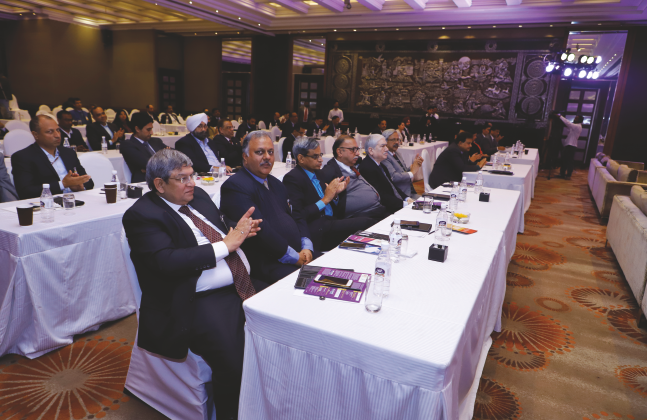At the fifth edition of Maritime CEO Conclave, Mr SivaSailam, Special Secretary Logistics speaks to audience extensively on how his department will deal with the challenging task of improving logistics scenario
The month of January is that time of the year when misty winter grips the capital region, but it was not a strong enough reason to dampen the enthusiasm and excitement of heavyweights from the shipping and logistics fraternity who look forward to this annual event with much anticipation as it brings together who’s who of the industry along with senior bureaucrats and policy makers to discuss issues and opportunities that matter the most. This year the Maritime CEO Conclave had the newly appointed Special Secretary Logistics, Mr Sivasailam take the hot seat as he explained the change in modus operandi of the Commerce Ministry brought in by the formation of the Logistics Division that has increased the ministry’s engagement with the stakeholders. The logistics division can further deliver and graduate to become a ministry as well, hinted Sivasailam. Other vital issues discussed include the need for a robust Port Community System and connecting all the stakeholders to this national portal, improving the last mile connectivity to reduce logistics cost and skill building in the industry.
In the second session, Col Prashant Kumar Mishra, Director (Operations), Land Port Authority of India made an elaborate presentation on trade happening with neighbouring countries through land ports, the potential to grow the trade volumes and the need for improving infrastructure.
CEO CONCLAVE SESSION ONE
ROAD MAP FOR REDUCING LOGISTICS COST
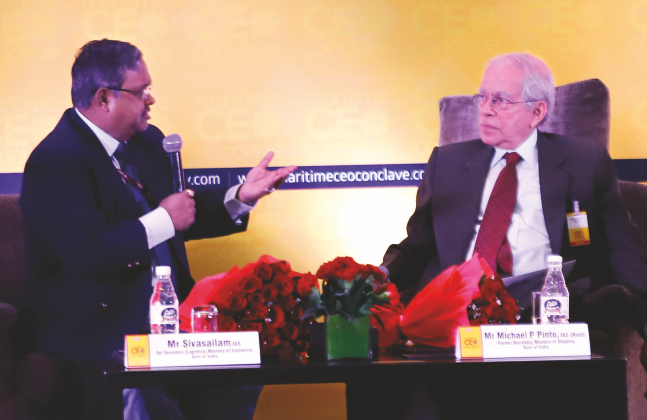
The fifth edition of Maritime CEO Conclave was more of a brain storming session wherein the government representatives and industry stakeholders participated with equal enthusiasm to raise and address some of the most pertinent logistics issues
The 5th Annual Maritime CEO Conclave brought together representatives from the government and the industry stakeholders to deliberate over the present and future challenges of the fast-changing business environment. The event saw high energy interactions by the participants who raised relevant issues with the authorities while putting forward suggestions to address some of the most pressing issues.
The first session of the conclave focused on a whole lot of aspects including need to look at logistics as a sector, ministries to engage more with the industry stakeholders, addressing logistics cost issues, a robust Port Community System and National Logistics Portal supporting the trade and the need for skill building in the industry.
Michael Pinto, IAS (Retd) Former Secretary, Ministry of Shipping, Government of India: We now have a Secretary Logistics in independent charge under ports reporting directly to the Minister. Now that you have been in this position for more than a month, how do you see your role? Can you tell us briefly what are the main things you would like to do?
Sivasailam, IAS, Special Secretary, (Logistics), Ministry of Commerce, Government of India:
We all know that the logistics division has been carved out in the Ministry of Commerce. What this has done? I see it like this – generally the Ministry of Commerce has always been concerned with imports and exports, so people have thought that if you are in a commerce ministry you have nothing to do with what’s happening within the country. You are basically concerned with exports and imports. Logistics Division has changed this mind set. For the first time Commerce Ministry is also concerned of what’s happening locally. The local trade is also part of the mandate of the logistics division. This obviously requires a change in mind set, and that comes by organising a department, organising a division which will address this issue. As long as you are in the main stream commerce, you would always be concerned with imports and exports, but the time you are logistics as a sector, you are not just concerned with imports and exports, but the whole lot of internal trade that is taking place. This is one change that has happened.
The second thing is the mandate hitherto from the time it was conceived it was largely a part of the mandate of Commerce Ministry, which means exports and imports, but now having made it independent the expectations of the industry and the expectations of the people at large would be that you look at logistics as a sector in its entity and not just in relation to exports and imports, extremely important as they may be.
The third thing is engaging with the industry is a paramount requirement because your only clients are the stakeholders in the industry. Whether the policies, practices, protocols, actions of various functionaries across the spectrum which addresses the logistics sector in its entity is in accordance with what is being planned, is a key deliverable of this department, so I do concede the point that the logistics department may not necessarily have its interest aligned with mainstream ministries, of course it may not be interfering with them. I assume it is the interest of the government that when the industry negotiates on these matters, a certain amount of power parity is restored and brought on par with the rest by involvement of the logistics division acting for and on-behalf of the stakeholders.
Michael Pinto: When we look at the extracts from the recent report by the Vivek Debroy Committee, one thing that I noticed was earlier we used to consider the cost of logistics as a percentage of GDP (in India the cost of logistics is 13 per cent of GDP, but in developed countries it is 8 per cent of GDP), but the Debroy Committee has looked at it as a percentage of consignment. What is the proportion of logistics in the consignment value, which comes to 15-17 per cent and it should be not more than 10 per cent which is the case in other countries. If you calculate on the basis of value of the consignment and then take the cost of logistics there is going to be a huge difference because some consignments are very large in nature but have a small value, while others may be small in size but have a larger value. So which way we should follow? Should we look at it as a percentage of GDP or consignment cost?
Sivasailam: let me draw a few caveats: when I took over I had specifically enquired that we all believe the logistics cost is 13-14 per cent of GDP, but where is the evidence? And I am surprised to tell you there is really no evidence, it is anecdotal. The actual value could be more or less, but we take the 13-14 per cent as a reasonable figure based on an expert analysis. The logistics cost could be a part of the GDP and there should be no problem about this, but what matters to businesses is consignment basis. For example, for a very high value item the logistics cost may be a fraction, but whether that fraction is worth or not is a matter of examination per se. For certain products like agricultural commodities (tomato) the logistics cost is twice of the product’s cost. While we say that it is the logistics cost whether the cost is to be borne or not is a matter to be decided in the facts and circumstances of each business and to that extent I would say logistics is a subject which businesses consider, but as a system we need to address it based on each consignment as to whether the cost which we are bearing is necessarily a thing which adds value in the market. I would support this view, as along with it are linked the taxation linked policies, policies for prioritisation, which are linked to the nature of the commodity. You may say that this will tantamount to achieving maturity of the sector fast, but since we have a lot of catching up to do, it’s better we hasten these aspects and look at it in a manner which makes business sense. Economy-wise if we make progress on individual product related activities and look at them to provide a modal analysis and find out the best modal way to transport goods then we will be in business.
Michael Pinto: If we are calculating the cost of logistics with respect to each consignment we could uncover a huge multitude since it is much more uneconomical to transport tomatoes because their cost is low and you are spending a lot of money transporting them. However, when you have oversized cargo and it costs a bomb for moving it from one place to another, maybe the percentage of logistics in value of consignment could be very high. But when the committee said the cost of logistics as a percentage of consignment is (X) how did they arrive at that I presume they have taken total value of all consignments, total cost of logistics and divided one by the other. So we are getting an average. It doesn’t tell us anything about the individual and I take the point that you are making, if it is an individual cost that you get then I fully agree with you, but if we are just getting an average how does it matter? Because it is probably better to get an average as a percentage of GDP?
Sivasailam: I would look at the oversized cargo a bit differently, it is a matter of logistics planning and most of the cost in transportation of oversized cargo is actually rent-seeking behaviors.
Amit Budhiraja, Managing Director,Utopia Freight Logistics Pvt Ltd:
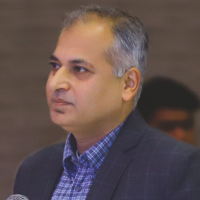
There was a study done by World Bank with regards to logistics cost and in fact DGFT also came out with a transaction cost report for exports in 2010. At that time it was headed by the Union Commerce Minister, Jyoti Radhe Sindhiya and it is available on DGFT website – both transaction cost report 1 and 2, which clearly highlights how they had achieved at the logistics cost. And when the World Bank achieved at the logistics cost percentage – they are pillars of doing trading across barriers, wherein the parameters are very well detailed.
Sivasailam: I am exactly quoting those reports, but we are extrapolating it as logistics cost as percentage of GDP, whereas the studies which were done were basically limited studies on basis of which this has been extrapolated.
Amit Budhiraja: I appreciate your point. Since 2010 in every conference I am raising the need to conduct sectorial logistics cost study but nobody has been heeding to my request. We can’t have a generic logistics cost study in a vast country like India where infrastructure, production area and culture varies massively.
Sivasailam: I agree with you and that’s the reason all of us as business stakeholders are happy with an assessment that it could definitely be 13-14 per cent. We have done the sectorial studies for coal, cement, rice and Iron ore, wherein we found that logistics cost is actually much more than 13-14 per cent, so a general average actually looks good. For coal it could be 17-18 per cent and same is the case for cement and these sectorial studies are helping us address certain modal shifts.
Shantanu Bhadkamkar, President, AMTOI:
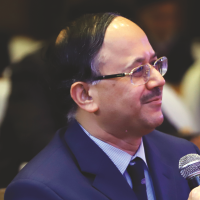
We have seen the benefit of having a department of logistics in a ministry, so we have been talking on this issue for a long time and for the first time this has been recognised. Now please allow me to give a bigger twist to this issue: 52 per cent of GDP is service sector and it doesn’t require transportation, so when we say 13-14 per cent, compared to goods it is actually 28 per cent. The second twist is – there is a component break up to the logistics cost which includes damage to the goods, cost of carrying inventory, wasted inventory, which has nothing to do with transportation. In any study the highest that they contribute to the transportation and storage is 30 per cent of this cost. When we mix too many things together the combination effect is such that you cannot actually understand effect of each segment and each variation. In financial analysis there is a well-established principle – that you change only one variable at a time and if you have too many variables and you try to multiply then it’s a conundrum you are creating.
Michael Pinto: Today logistics is a full fledge department wherein the secretary reports directly to the minister and not to another secretary, so I was wondering whether it should be a department within the Commerce Ministry or whether it should be a full ministry? When we look at logistics we have a large number of ministries involved obviously the biggest ministries are the shipping and roads. But we also have transport by air looked after by civil aviation, transport by rail, looked after by the railways then we have the commerce ministry from where the permissions for CFS are issued and then we have the Customs. Now Customs come under the Finance Ministry, but they interpret the same circular differently at different ports. If you do not have a logistics ministry how will you get the other ministries to play the ball?
Sivasailam: Presently, logistics in the Commerce Ministry is a division and not even a department. Commerce Ministry has two departments – IPP and commerce. Logistics division reports directly to the minister. Whether it should be a department? Whether it becomes a department first and then scales up to be a ministry would entirely depend upon its performance. Whether it makes sense in terms of its deliverables? If you are given the independence to formulate which means the stakeholders in the industry and government are all watching, so if the division makes an impact through facilitating the stakeholders performance and improved results on the ground, I would say that we could actually stake a claim to be a department. I have performed on the ground and I do believe that the upgradation as a department should come as a reward rather than as an administrative decision. That will keep the logistics subject on its tenterhooks to deliver rather than claim it as a right.
As regards to rest of the ministries, each one of them has got its internal technical aspects. When you talk about shipping its not just logistics, logistics is at the business end of it. But shipping has got a whole lot of technical aspects and so are the rest of the ministries. It is those technical aspects which relate to those ministries, but the interfaces between the businesses will be the function of logistics. Interventions will actually depend upon:
- Whether the proposal or intervention makes economic sense.
- Who gains and who loses?
- Whether it also makes a social sense?
I am certain if you are able to address these three then we have our hands right on the deliverable. Its not necessary for the logistics ministry to say how are you going to organise the shipping industry? That they can take care by themselves, but certainly the business aspects of interfaces will be the function of the logistics ministry.
Michael Pinto: I will look at it with greater detail. In the ministries of shipping and road transport, which used to be the MoST in the past, if Ministry of Logistics is located there these two come under it as two fullfledged departments with secretaries and ministers of state. Then you have the question of civil aviation. But the Ministry of Civil Aviation looks after a whole lot of things besides logistics. So only those areas concerning movement of cargo by air can come to the logistics ministry. Similarly in railways, everything else passengers, electrification, rolling stock, lines and the whole gamut of their operations remains with the railways, but only the matter of where you build the lines and how you link them to ports can be with the ministry of logistics. The most difficult thing will be Customs. When a customs officer is posted to a particular port, only for that purpose he comes under the ministry of logistics and for the rest it remains with the Ministry of Finance. How do you react to this scenario?
Sivasailam: Today the ministries of shipping, road transport and the Customs are the big boys and they are all in their middle ages. Now they have together formed the division of logistics. Now it entirely depends upon whether we are going to be business led and show results. If the collective wisdom of the stakeholders across these ministries if they find the collective wisdom of businesses is capable of best being addressed by the ministry of logistics to which these businesses could be reporting, it could happen much later, as it has happened in the mature countries. The question is whether the ministry of logistics and the businesses and the stakeholders can carry it forward together. You have to deliver to show the big boys and have an ecosystem to back you in order to make that happen.
Amit Budhiraja: Can I say that the division of logistics could be the harbinger of era of single window which is much needed for logistics? What initiatives could this division take in near future that could help it transform and leapfrog?
Sivasailam: I have had limited practical experiences as of now, but I can quote from what it is, for example, the concept of port dwell time which we are looking at JNPT and Mundra and which is also published on a monthly basis. The nature of dwell time when you look at it in JNPT and Mundra is totally different. One is pre customs and other is post customs, so the incidence of logistics cost for the same dwell time is different at both the ports. These are the things which can be addressed.
The next point is issues of facilitation. For example, Customs clearances: Customs is one aspect on the revenue side but there are 43 Participating Government Agencies (PGAs) concerned with customs clearances, the mantle of which falls on customs, but customs is not necessarily accountable for it. Plant/animal quarantine, wildlife imports need to be governed by risk management protocols, none of which are known, understood or differentially implemented even within ports which are separated by 30km. so you have a whole area of interpretational and design issues on these protocols. When we say that we need to work 24X7, not many PGAs work 24X7. If we need animal quarantine at 20 of our major ports, as opposed to 4 or 5, how do we get them doing? Can we have a public service privately provided? Can we have certain aspects of these regulations privately provided but addressing business requirements? I would consider a lot of my role to be proactive and on the ground. Policy making issues would arise depending upon these practical realities.
Michael Pinto: Do we really have a robust PCS? Ideally I thought that in a PCS the whole system should be like an EPBX and all the different agencies – ports, shipping lines, shippers, importers, exporters and customs should be logged in to be part of it. Is that really happening now? In the “PCS 2+” I don’t know if that covers everything, because it certainly covers the ports and shipping lines, but I am not sure whether it covers the Customs, importer and shipper?
Sivasailam: My first reaction on PCS 2 is that I have not yet seen any industry reactions on it so far. Maybe the industry reaction on it is muted because the introduction of it is done with the caveat that up to March 31 it will be on trial. Maybe industry is looking forward to a post-trial reaction, I am not sure. But once an industry reaction comes on it, it will be possible for us to look at it further.
Yes, it does not cover a whole lot of other interface things, but I do believe that it’s going to link to ICEGATE and SWIFT.
- Ramakrishna, Chairman, FFFAI:
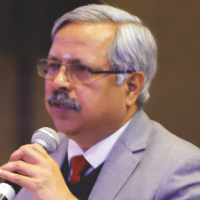
In PCS the problem is that the shipping lines have got their own PCS, air cargo has got its own PCS, probably the transporters will tomorrow have their own PCS. What is more important is the integration of all these things. There has to be a common portal and it costs money as well because most of the PCS, except in the public sector, are going to charge some cost. If we are talking about the logistics cost to be realistic, I think this has to be seen in a different manner.
Sivasailam: One of the mandates that is publicly informed by the ministry is the creation of a national portal on which lot of work has been done in the last one month. It is a platform of platforms. On the lower base platform anybody can plugin. FFFAI or AMTOI members and anybody in India wanting to do business can plugin. To ensure that certain business gets created on that platform the National Logistics Portal will sit as a platform. The National Logistics Portal contains two towers – a government tower and a service tower. The government tower integrates all the PGAs and any future PGAs which will come. The logistics division as part of the government will ensure that all governmental entities or all regulatory entities with which you need to do business will be on that portal.
When you look at the import/ export, you talk about the 43 Participating Government Agencies (PGAs). When you talk about internal trade you include state governments as well and many sub-regulations inside state governments. The whole idea is to have PGAs incorporated in a governmental portal. The second is the service portal which integrates the service profiles of anybody who would like to be a part of it. It will include ports, aircargo, logistics service providers, Customs. While we definitely provide the public sector comparator, it’s not necessary I restrict myself and monopolise this. It is open to other bodies to provide parallel service. If you want to improve service deliveries and say I am going to provide better service you will be allowed a plug-on and a link to the governmental towers. While I will provide a public sectors comparator service integrating all services, it’s also available that lot of you can join together and provide these services. You can provide auctioning, reverse auctioning, multimodal services and much more. The business environment can be recreated on a service portal by any one acting individually or in connection with other industries.
Shantanu Bhadkamkar: In the exim trade the customs ICEGATE and NIC Portal is got all the tools, so why every department should spend separately?
Sivasailam: I am not going to do that. ICEGATE will be integrated and brought into use.
Michael Pinto: Can the National Logistics Portal work in real time?
Sivasailam: It’s an online portal and the idea is to have Indian businesses provide services across the globe. A foreign service provider can use this portal, but they may not require the Indian government PGA tower benefit, but they can always use the tools available.
Surendra Lingareddy, Director Operations, APAC, Volteo:
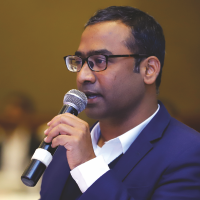
One of the things I would like to mention as a comment is that we often see the industry having siloed data approaches. You have mentioned about all the stakeholders being able to plugin and participate, but the data is going to be as good if you are able to mine it and one of the things that I urge for is this logistics data to be available for third parties like us, so that we can provide intelligence on top of it.
Sivasailam: There are two things which we are developing – one is a national portal about which I just spoke. This develops a lot of business sensitive data. Now one of the things which I need to promise every business is that the data is safe. To that extent businesses sensitive data is not available to third parties, but it is available among the people using the portal to the extent it is authorised by the businesses. The data is always available for use in a disaggregated manner without disclosing the sensitive information of businesses.
The data can be used for social purpose such as promoting business clusters or for providing additional logistics hubs, such that the business in those regions benefits, but the portal operator itself may not be able to use it for commercial purpose. We would be feeding this anonymised data into a logistics tool with different layers such as a road layer, rail layer, port layer, shipping layer, inland waterways layer, Customs layer and the data can even be crowd sourced. These tools are available publicly for anybody. We also request industry and associations to populate that tool for making informed decisions. The portal will have an app tower and anybody can put in their apps useful to a large community either for free or on paid basis.
Michael Pinto: we are not so good in last-mile connectivity and that is what drives up the cost as the method of transportation is uneconomical. What solution do you have to this?
Sivasailam: If you are going to set up anything new, better get into the industry for point zero. That is the way you leapfrog. There is no point designing a physical facility based on the old design. This is the best possible way I see for the inland waterways. The north eastern region will get immensely benefitted through the waterways, but the point is we need to be proactive and quick on policies. I do not see a policy on inland waterways in relation to PPPs.
Be it inland waterways or coastal shipping, I do not see a very small volumes making sense, unless somebody is integrating the cargo. But I do see the benefits of bulk movement in food grains, coal and iron ore. A multimodal logistics plan has been just worked out to take food grains from Punjab, rake loads transported to Kandla and offloaded at Cochin which then travels around to be offloaded at Tuticorin in Visakhapatnam. Ultimately it depends on how are we going to make economic sense, but I do see this happening in respect of bulk for the time being.
Sushil Kumar, Senior Advisor, Society of Indian Automobile Manufacturers:
Image
Talking about transportation of finished vehicles from the factory to the dealers, the first and last mile connectivity is a problem. But aggregation at the port is also a problem and suitable ships are also not available. I suggest can we have Ro-Ro ships where we can load the truck at the factory, the truck reaches the port, rolls-on to the ship, rolls-off at the destination and the same truck moves on to the dealers. That could be a possibility, but otherwise also the policies need to be looked at with respect to shipping for low volume vehicles, because volume VS weight ratio of vehicles is very different from other commodities.
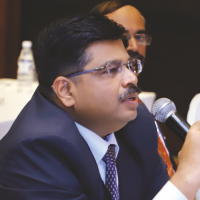
Shailesh Garg, Director, General Manager, Drewry India:
Extending this point on Ro- Ro, I think one of the reason is that because of the time that is spend on the voyage for the trucks to be parked on the ship, many of them are not very keen to do that and one way to overcome is just to have the prime mover bring the trailers and drop it on the vessel and at the other end you can have another set of prime movers taking them out. So you save on the capital cost and the drivers cost as well.
Sivasailam: I have not seen any proposals from the industry on this issue. I can give you an anecdotal understanding of this: when I last went to Mundra it was brought to my notice that if the horse and the chassis are separated the logistics cost in that component will decline by almost 60 per cent. But the issue is in this country we do not have a separate registration for the horse and the chassis. I have not seen any representation made by automobiles as a group for this request at all.
Capt Sanjeev Khanijo, VP – Commercial & West Coast, Transport Corporation of India Seaways Ltd:
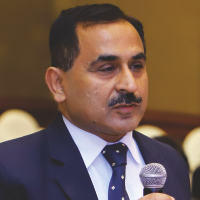
We have had 2-3 interventions of these different Ro-Ro companies coming in and trying on the coast. Unfortunately none of them were commercially viable for the vessel owners as such reason being, the automobile owners compare the cost directly to the road and they do not want to pay anything extra. The Ro-Ro vessels have high GRT and the port charges are based on GRT although the government did give some waver, but if a policy can be made to link it to the DWT rather than GRT that would be much better for the vessel owner as such.
Shailesh Garg: If we can add carbon footprint as an added advantage for the people who are using it, I think the cost disadvantage can be further reduced to them.
Sivasailam: As part of the logistics division we have also created a Center of Excellence in the Indian Institute of Foreign Trade. If industry works proactively, we could also get IIFT to study some of these aspects and develop formal studies to address these issues in a manner to help decision making.
Michael Pinto: The Vivek Debroy Committee Report mentions the need to incentivise the trucking industry to increase in size and scale. Today we have a large number of single truck owner companies and if we do not have this movement to increase in size and scale we are never going to really bring about a complete change in the industry. How do you plan to incentivise the truckers and how much will it reduce the cost?
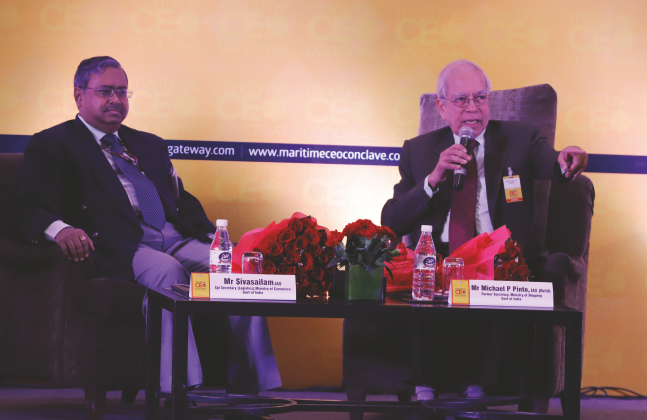
Sivasailam: It promotes entrepreneurship and employment. One way is by addressing the skills requirement and certain amount of employee relations because we do not have a system of having professional drivers. When drivers go on a long journey they sleep on the road side and we need to address these issues. In India truck driving is not a professional business as it is developed in US and other parts of the world. We need to promote truck driving as a professional activity and make it much more respectable. Professionalization and skill improvement is an important aspect. For instance, TCI has about 100 acres of land in Pune for driver skilling and they are looking for support to make it happen.
Michael Pinto: what initiatives need to be taken for skill building in the logistics sector?
Sivasailam: I am happy to tell you on January 25 in Chennai the first set of syllabus – the qualification pax for the logistics sector skill council which has been pending for the past 7-8 months due to lack of an incumbent will be cleared. This is the first step and I have requested that the industry should be present. If the industry feels that a certain amount of syllabus and skill certification is OK with them, then it will go through. Should it be not OK with them then it will not go through. Because it has to be industry led and the people who are trained there need to be recognised by the industry. The logistics sector skill council already has a lot of industry mind and that is the best aspect of it. Right from ab initio it has got the industry support.
Dr Rakesh Singh, Institute of Supply Chain:
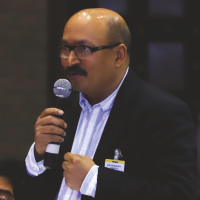
I think logistics industry is very skill training resistant. I think there is no mechanism to really provide training unless the training is also provided to the very fragmented industry employers. We do not have the right set of trainers in the country, so even if the skills council intends to extend its provision in the industry, the flight by night operators are also given license because they have 2500 sq.ft space unlike any other institution, but they do not have the right capability. There is a much wider need for structural reforms. There is need for setting up a vocational cum university which can really provide the right skills for the country to skill-up to the needs of the fast changing requirement of the country.
- Ramakrishna: All professional associations should endeavour to have meaningful training hours in a year for our employees and that will automatically develop skill base.
Sivasailam: There should be a differentiation between training and skilling. Skilling is different from development of knowledge. And the levels at which these are done are totally different. The skilling of professionals at managerial level is quite different from the skilling of technicians. We generally forget these principles and therefore we have narratives of having skilling universities. Whatever training is offered we should make sure it is available online as well.
CEO CONCLAVE SESSION TWO
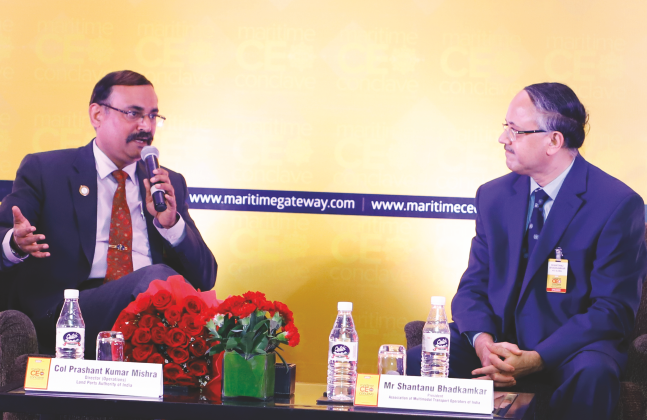
Cargo movement at borders: Challenges to be dealt
Indian trade with South East Asian nations can be developed 10 times through the ICPs, provided necessary infrastructure and facilities are put in place, says Col Prashant Kumar Mishra, Director (Operations) Land Ports Authority of India
To facilitate intraregional trade across the borders, integrated check posts have been setup which are controlled by the Land Ports Authority. In the second session of the Maritime CEO Conclave, Col Prashant Kumar Mishra, Director (Operations) Land Ports Authority of India detailed on the land ports operational and under development, services offered by them and issues faced in moving cargo.
Logistics today is no longer looked at as cost, but is looked at as a profit center which has to be leveraged. Technologies such as BlockChain, GPS, AI will come and evolve the system and once a critical mass is reached in these technologies, then no intervention will be required and economies of scale will take over.
Who will be the change agents in this process? They can be divided into three blocks:
- The think tanks, Niti Aayog and research houses who are framing the policies at the broader level.
- People building the infrastructure – Commerce or rail ministry
- The CEOs of logistics companies
A common platform where all the three blocks can come together is missing. These blocks make their plans in silos but it is not shared with each other, as a result things don’t happen the way they need to happen.
Coming to the functioning of the Land Ports Authority he said, the focus of Land Ports Authority is to break the barriers and build relationships for safe and systematic border crossing to take place. At present the trade taking place at the land borders is less than 5 per cent of the total trade taking place in this country. Challenges facing the cargo movement through land ports include high transportation cost, inadequate border infrastructure, procedural complexity, cumbersome cross-border facilitation, multiple handling and inefficient border corridors, different standards on vehicles and drivers across countries, absence of integrated cross-border transportation network and regional transit system, delays at the borders due to different operating hours, trucks need to be changed at the border which is time consuming.
We have five functional ports right now and at some of them there is a delay of as much as 10 days, which increases demurrage charges that reduce traders margins. At Petrapole the delay for cargo to reach the gates of ICP is reduced from 10 days to 2-3 days.
Access to north eastern market
Land ports offer an opportunity for connecting with the north east. Cargo from Agartala travels 1,645 km to Kolkata, while direct distance would be around 350 km, if movement via Bangladesh was available. Thus the products in the north east can be made viable for exports to other countries. Right now they are not even viable for marketing into mainland India. North East exports need to travels to Kolkata over a 1,500 km distance; if access to Chittagong port was available, it could save 60% of the distance and cost.
We have agreements with Bangladesh for integration of railways, but necessary infrastructure has to be there and the industry has to participate to make it possible. Indian trade with north east can grow up to 10 times through the ICPs.
Currently India has 5 functional integrated check posts and a 6th has also become functional about a month ago. They are located at Atari, Amritsar; Raxaul and Jogbani at Indo-Nepal border; Petrapole and Agartala at Bangladesh border; the ICP at Dawky in Meghalaya is under construction, ICP Moreh is also functional located at Indo- Myanmar border. Road connectivity has to improve and the agreements with Myanmar have to change a little then only the trade can pick up. The ICP is part of the Asian Trilateral Highway and in general we are looking at enacting the South East Asian connectivity, this is the point for connecting to South East Asian countries. Recently, the foundation stone for ICP at Rupaidiha was laid. It is in UP, about 200km from Indo- Nepal border. The national highways from Guwahati to Imphal, Moreh and Myanmar are being developed by India and the construction of bridges has already started.
The ICP offer integrated facilities for trade and passenger facilitation, single window clearance, warehousing, parking spaces, safe movement of cargo. At present the container movement at ICPs is very less because at the border trucks have to be unloaded and cargo shifted into the trucks of the other country. As of date we have 69 land customs stations functional, of which we are addressing 20 at which 95% of the trade happens.
Bangladesh
At ICP Petrapole, LPAI has been making efforts to reduce the traffic congestion at crossing point, due to which Bangladesh started accepting more than 450 vehicles in a day. Bangladesh Govt. has also created additional parking space. On the Indian side, CWC has streamlined the parking area. All these efforts reduced the congestion at ICP Petrapole.
Indian government has plans to connect via Chittagong Port to Tripura which is just 70km. The southernmost tip of Tripura is Sabroom where India is building a bridge for border crossing. An ICP is also included into the plan and is connected via rail to Agartala. A four lane highway is being developed. Nischintpur is another LCP being developed in Tripura.
Nepal
The only direct rail link from India to Nepal is at Raxaul. More than 40 per cent of Indo-Nepal trade passes through Raxaul-Birganj border. LPAI proposes to develop a rail siding with container handling and warehousing facility within the ICP complex.
Challenges in developing ICPs
Major challenges include land acquisition, coordinated planning for rail, road integration, reliable power, mobile and internet connectivity, integration of ICP operations on a single IT platform, warehousing, parking, cold storage facilities.
Shantanu Bhadkamkar, President, AMTOI: Is interaction of stakeholders from both the sides possible?
Col Prashant: The dialogue is very essential because everything right from the trade timings to procedures is to be addressed. Common testing facilities and recognition of each other’s standards need to be brought in. We have an infrastructure group that meets once in a year with Bangladesh counterparts and we have requested the Ministry of Commerce to conduct a port level meeting with Bangladesh, Nepal and Pakistan. Currently the meeting takes place between the Customs authorities, railways authorities but not at the port level.
A M Srikanth, General Manager – South, VS&B Containers Group: Are domesticated containers allowed to cross the check posts into other countries and come back? As per law when a domesticated container leaves Indian territory and comes back, the sanctity of paying duty gets void and the Customs ask for paying duty the second time the container comes in. Is there any impact on that?
Col Prashant: With different countries we have got different agreements. With Nepal we have a Transport Service Agreement that allows trucks to move on either side




